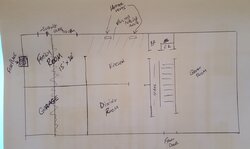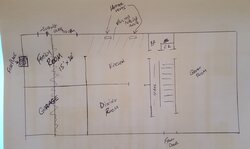Hi All,
I am brand new to the forum - and new to wood stoves/inserts. I have already spent close to two hours reading other posts and responses, etc., but I still need to ask for some guidance. I was planning on a wood insert for an existing, masonry fireplace opening. It is 36" wide, 30 1/4" high, 23" deep. It tapers back to 28 1/2' wide. It has an elevated hearth 18" wide (12" or so off the ground). The room is our family room, on a slab with no heat. The room is about 15' x 20' with a vaulted ceiling about 15' high. The insulation is good, but it has two skylights and a three gang glass sliding door on one wall. Yes, there is a ceiling fan. Our kitchen is the adjacent room with an entrance into the family room about 10' wide and the vaulted ceiling continues into this portion of the kitchen. The kitchen does have two heater vents (gas, forced air), but it gets cool/cold without any heat in the family room ... especially in the open area going into the family room. We had a gas insert that worked well, but it needs to be replaced and we would like to go with wood.
I am really only looking to heat the family room and help warm the kitchen. I have a center hall colonial, but the family room is off on the side by itself (again, adjacent to the kitchen). Inasmuch as I would love to heat more of the house with a stove or insert, I see no way to get heat to the rest of the house (other than the kitchen) - (there are no returns in the family room or the kitchen).
My questions are:
(1) I was assuming I would go with an insert, but have seen many who go with a wood burning stove sitting in front of, or in the opening. What are the advantages / disadvantages of going with an insert vs a stove?
(2) Is it OK to simply get the original fireplace going again like it was in 1975? Any simple modifications to make this a viable option?
(3) In considering an insert, I looked at a Napolean and Vermont Castings, but was having trouble with the expense ~ $3000. The models I looked at did about 55,000 BTU's. I have since read on this site about the Englander and Century models and would definitely go with one of these less expensive options. Are there other recommendations?
As an aside, I am planning to install myself. Sorry for being so long winded. I appreciate any help.
Thanks,
John
I am brand new to the forum - and new to wood stoves/inserts. I have already spent close to two hours reading other posts and responses, etc., but I still need to ask for some guidance. I was planning on a wood insert for an existing, masonry fireplace opening. It is 36" wide, 30 1/4" high, 23" deep. It tapers back to 28 1/2' wide. It has an elevated hearth 18" wide (12" or so off the ground). The room is our family room, on a slab with no heat. The room is about 15' x 20' with a vaulted ceiling about 15' high. The insulation is good, but it has two skylights and a three gang glass sliding door on one wall. Yes, there is a ceiling fan. Our kitchen is the adjacent room with an entrance into the family room about 10' wide and the vaulted ceiling continues into this portion of the kitchen. The kitchen does have two heater vents (gas, forced air), but it gets cool/cold without any heat in the family room ... especially in the open area going into the family room. We had a gas insert that worked well, but it needs to be replaced and we would like to go with wood.
I am really only looking to heat the family room and help warm the kitchen. I have a center hall colonial, but the family room is off on the side by itself (again, adjacent to the kitchen). Inasmuch as I would love to heat more of the house with a stove or insert, I see no way to get heat to the rest of the house (other than the kitchen) - (there are no returns in the family room or the kitchen).
My questions are:
(1) I was assuming I would go with an insert, but have seen many who go with a wood burning stove sitting in front of, or in the opening. What are the advantages / disadvantages of going with an insert vs a stove?
(2) Is it OK to simply get the original fireplace going again like it was in 1975? Any simple modifications to make this a viable option?
(3) In considering an insert, I looked at a Napolean and Vermont Castings, but was having trouble with the expense ~ $3000. The models I looked at did about 55,000 BTU's. I have since read on this site about the Englander and Century models and would definitely go with one of these less expensive options. Are there other recommendations?
As an aside, I am planning to install myself. Sorry for being so long winded. I appreciate any help.
Thanks,
John





